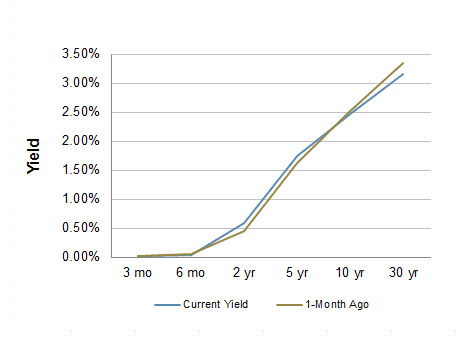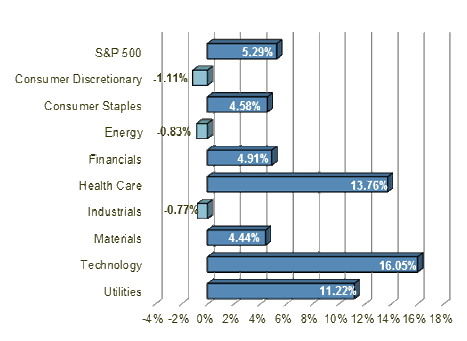 Clarksville, TN – There were plenty of economic data reports, but the financial markets mostly obsessed about other things (quarter–end positioning, soft global growth, geopolitical tensions, Ebola). The headline figures from the employment report were better than expected, a positive for stocks and a negative for bonds.
Clarksville, TN – There were plenty of economic data reports, but the financial markets mostly obsessed about other things (quarter–end positioning, soft global growth, geopolitical tensions, Ebola). The headline figures from the employment report were better than expected, a positive for stocks and a negative for bonds.
Nonfarm payrolls rose by 248,000 in September, while the two previous months were revised a net 69,000 higher. Some of the strength reflected a rebound from special factors that had reduced the August total.

The unemployment rate fell to 5.9%, partly reflecting lower participation. The seasonally adjusted unemployment rates for teenagers and young adults rebounded, while the rate for prime-age workers (25-54), fell from 5.3% to 4.9% (reflecting a plunge in participation – very weird). Average hourly earnings were flat (-0.041%), up 2.0% y/y (the CPI rose 1.7% in the 12 months ending in August).
Adjusted for inflation, personal spending (70% of GDP) rose 0.5% in August, but combined with disappointing September auto sales, appears to be tracking at about a 2% annual rate for 3Q14. The Conference Board’s Consumer Confidence Index slipped in September. Pending home sales fell in August. The ISM surveys declined. Factory orders and shipments continued to suggest a relatively strong 3Q14 trend in capital spending.
Next week, global growth is likely to remain a key concern for the markets. The IMF will update its World Economic Outlook on Tuesday. Minutes of mid-September Fed policy meeting are unlikely to provide any new revelations, but there’s always a chance that the markets will take something out of context.
Indices
| Last | Last Week | YTD return % | |
| DJIA | 16801.05 | 16945.8 | 1.35% |
| NASDAQ | 4430.20 | 4466.748 | 6.07% |
| S&P 500 | 1946.17 | 1965.99 | 5.29% |
| MSCI EAFE | 1799.52 | 1866.41 | -6.06% |
| Russell 2000 | 1096.38 | 1110.24 | -5.78% |
Consumer Money Rates
| Last | 1-year ago | |
| Prime Rate | 3.25 | 3.25 |
| Fed Funds | 0.08 | 0.05 |
| 30-year mortgage | 4.17 | 4.46 |
Currencies
| Last | 1-year ago | |
| Dollars per British Pound | 1.615 | 1.620 |
| Dollars per Euro | 1.264 | 1.352 |
| Japanese Yen per Dollar | 108.580 | 97.380 |
| Canadian Dollars per Dollar | 1.112 | 1.035 |
| Mexican Peso per Dollar | 13.419 | 13.219 |
Commodities
| Last | 1-year ago | |
| Crude Oil | 91.01 | 104.10 |
| Gold | 1213.83 | 1293.85 |
Bond Rates
| Last | 1-month ago | |
| 2-year treasury | 0.58 | 0.45 |
| 10-year treasury | 2.46 | 2.52 |
| 10-year municipal (TEY) | 3.43 | 3.62 |
Treasury Yield Curve – 10/03/2014
S&P Sector Performance (YTD) – 10/03/2014
Economic Calendar
| October 8th | — | FOMC Minutes (September 16th-18th) |
| October 13th | — | Columbus Day Holiday (bond market closed) |
| October 29th | — | FOMC Policy Decision (no press conference) |
| December 17th | — | FOMC Policy Decision (Yellen Press Conference) |
Important Disclosures
US government bonds and treasury bills are guaranteed by the US government and, if held to maturity, offer a fixed rate of return and guaranteed principal value. US government bonds are issued and guaranteed as to the timely payment of principal and interest by the federal government. Treasury bills are certificates reflecting short-term (less than one year) obligations of the US government.
Commodities trading is generally considered speculative because of the significant potential for investment loss. Markets for commodities are likely to be volatile and there may be sharp price fluctuations even during periods when prices overall are rising. Specific sector investing can be subject to different and greater risks than more diversified investments.
Tax Equiv Muni yields (TEY) assume a 35% tax rate on triple-A rated, tax-exempt insured revenue bonds.
![]() Material prepared by Raymond James for use by its financial advisors.
Material prepared by Raymond James for use by its financial advisors.
The information contained herein has been obtained from sources considered reliable, but we do not guarantee that the foregoing material is accurate or complete. Data source: Bloomberg, as of close of business October 2nd, 2014.
©2014 Raymond James Financial Services, Inc. member FINRA / SIPC.




